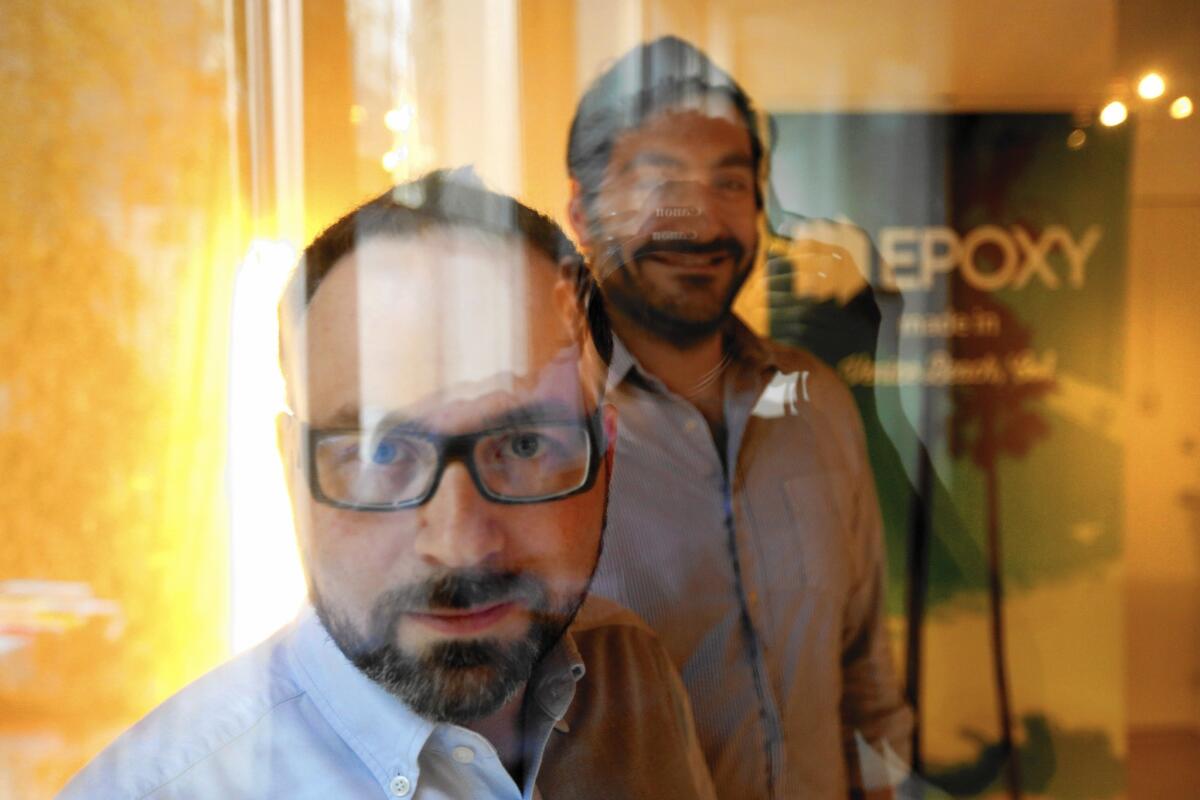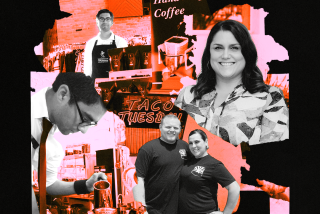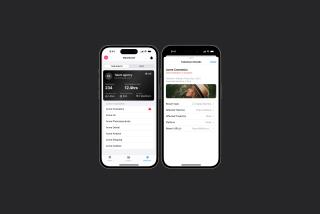These Stanford graduates want to help you run a YouTube empire

Aspiring stars in Los Angeles used to measure success by the number of parts or auditions they snared.
Travel vloggers Damon Dominique and Joanna Franco do it by brewing a pot of coffee in the morning, opening their laptops and counting the number of new comments, mentions and likes they tallied.
The duo, known online as Damon and Jo, have attracted advertisers by amassing more than 210,000 subscribers on YouTube. That’s enough of a following to hopefully never have to walk dogs or deliver groceries again.
But maintaining that momentum won’t be easy. It takes a relentless pace of new content and round-the-clock tending of fans on social media. “When you get to a certain level it’s impossible to see every YouTube comment,” said Franco, a 23-year-old native of Rio de Janeiro who grew-up in Connecticut and moved to L.A. last summer. “It’s easy to say, ‘I’m overwhelmed.’”
Without the means to hire a team of publicists, agents and assistants, Dominique and Franco turned to software developed by a Venice start-up called Epoxy to maximize their digital influence. The company’s tools bolster the art and science of Internet fame, giving so-called content creators, in the parlance of the digital video world, a badly needed edge at a time when competition is fierce.
Epoxy does this by merging Damon and Jo’s YouTube, Facebook, Twitter and Instagram accounts, allowing them to post new clips and pictures on any of those networks from one place.
“I don’t have to have 7,000 tabs open anymore,” said Dominique, a 24-year-old native of Fort Wayne, Ind., who became close friends with Franco at Pace University in New York.
Settings can also be toggled so that the pair are notified any time someone with a big social media following gives them a shout out -- a golden opportunity to reach a wider audience with a simple reply.
The emergence of companies like Epoxy underscores the breadth and sophistication of today’s YouTube and online video ecosystem, which only recently was dismissed as a compendium of cat videos rather than an alternative to traditional entertainment.
There are now 165,000 YouTube creators around the world with followings of at least 10,000 subscribers, according to Tubular Labs, a Mountain View, Calif., digital video analytics company.
Within that community, 8,600 creators have at least 250,000 subscribers (also known as “now you can quit your day job” level), 4,100 have a following of at least 500,000, and 1,800 have at least a million subscribers.
Those at the top of the heap such as Lilly Singh, Tyler Oakley and PewDiePie command millions of dollars in endorsements and brand campaigns.
“It’s a more crowded environment,” said Allison Stern, co-founder of Tubular Labs, which offers creators free software to chart their influence. “I do think it’s definitely harder to become a star today than before.”
Creators compete with one another for eyeballs and brand campaigns. Advertisers look for the top influencers in targeted markets.
That gave rise to an industry connecting advertisers to creators led by start-ups such as Zefr in Venice, Famebit in Santa Monica and OpenSlate in New York.
Although Epoxy also wants to help the most established creators maintain their social media empires, it largely helps up-and-comers find their footing.
The company was co-founded in 2012 by Stanford graduates Juan Bruce and Jason Ahmad, who both have backgrounds in design and engineering.
The idea came when Bruce served as head of digital at Team Downey, a production company founded by actor Robert Downey Jr. and his wife, Susan.
Team Downey was making a Web series and asked Bruce and Ahmad to research why some online videos prospered while others didn’t regardless of production value.
Bruce and Ahmad interviewed top YouTubers like Jenna Marbles and Hannah Hart, ad agencies, Hollywood studios and multi-channel networks that were representing the biggest digital stars.
Using the Downey name helped open doors for the soon-to-be founders. When they were done, they were surprised by what they discovered.
“Winning in online video very often didn’t have anything to do with the video itself,” said Ahmad, now Epoxy’s chief product officer. “It actually had more to do with all the activity surrounding community building.”
The way beauty vlogging star Michelle Phan explained it to them, you have to build an audience first by promoting a new video on Twitter, Facebook and Instagram before you can expect to rack up views on YouTube and elsewhere.
“All these different networks support each other. They’re not the islands people had traditionally thought they were,” Ahmad said.
At one point, Epoxy studied the social media workings of YouTube star Tyler Oakley by printing out all his posts for one week and taping it to the walls inside the company’s headquarters, a Frank Gehry-designed loft that used to be part of Dennis Hopper’s compound blocks from Venice Beach.
The six videos and more than 350 social media posts Oakley produced that week showed the team how to keep a fan base engaged, particularly by repackaging content into memes and gifs and being active on as many different social networks as possible.
Bruce and Ahmad started building Epoxy while at Team Downey and spun it out when they realized there was demand for the software across the online video industry.
In 2013, Epoxy raised $2 million in a seed round led by Santa Monica’s Upfront Ventures. The following year, it raised another $6.5 million in a Series A round led by Time Warner Investments and Upfront Ventures. Included in that round was Downey Ventures.
Mark Suster, managing partner at Upfront Ventures, said Epoxy wasn’t a short- term bet. The rise of Netflix, Hulu, YouTube and HBO’s streaming service signaled the end of a stranglehold on distribution by a handful of powerful media companies. That will eventually lead to a surge in demand for more content and the people needed to make it, he said.
“We believe by capturing the most elusive part of the market – the creators – we become infinitely more valuable to distributors who want access to talent,” Suster said.
When Epoxy officially released its publishing platform in May 2014, it included an editing tool to tailor video for the different social networks, a scheduling feature so that content could be posted strategically and a system to sort social media interactions so that creators could quickly respond.
The company released a mobile version of its software in September and recently released a feature where, instead of replying to posts in text, users can do it with a short video clip.
The company charges between $19 and $109 a month for access depending on the level of service desired. About 60 multi-channel networks, including Fullscreen, Maker Studios and AwesomenessTV, have purchased bulk subscriptions to Epoxy.
“Programming a YouTube channel can easily be a full time job,” said Chris Erwin, chief operating officer of Big Frame, the talent management arm of AwesomenessTV. “Being able to quickly edit content down into gifs and other media for social engagement, as well as better track and engage your top fans, is a big win.”
Bruce declined to say whether the company was profitable and it’s unclear how many creators are using the software. The company will only say that its clients collectively capture about six billion views on YouTube each month. For comparison, Maker, a Disney-owned multi-channel network with stars such as PewDiePie, attracts 10 billion views each month.
For creators, many of those views are hard won.
“It’s a really hard, exhausting, fragmented life,” said Bruce, Epoxy’s chief executive. “But on the plus side for us, if you can solve for that, you can win loyal users.”
So how essential is a service like Epoxy?
Justine Ezarik, a well-known YouTube personality who first went viral in 2007 after posting video of her 300-page iPhone bill from AT&T, said the tools available to creators today are far more sophisticated than when she started.
“You have to be analytical and on top of everything to compete these days,” said Ezarik, 31, better known by her YouTube handle iJustine.
But she said managing views and subscribers can sometimes become obsessive and counter-productive.
“You stop creating content,” said Ezarik, who often prefers asking her sister what she thinks of her latest video rather than look at results on YouTube’s data page.
That may be true for someone like Ezarik, who is established enough to have earned roles on network TV shows. But Damon and Jo, the travel vloggers who teach millennials how to see the world on a shoestring budget, say they can ill afford to neglect their numbers.
“Companies are looking closely at your influence,” said Franco, who along with Dominique, just joined a year-long marketing campaign with AT&T. “If you don’t know your value as someone with influence, you’re not doing your job.”
Twitter: @dhpierson
MORE ON TECHNOLOGY
5 futuristic oddities from the weird world of wearable tech
Who’s the driver of that Google car? Feds ready to say it’s the computer
Venture capitalists increase scrutiny on start-up deals amid stock market anxiety







